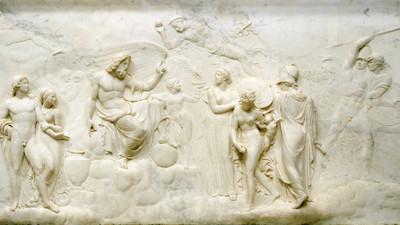Few subjects have inspired artists over the centuries as much as love. But these works of art don’t always capture a scene of bliss. In fact, artists have depicted everything from love and lust to heartache, jealousy, sadness, and even tragedy. The following works of art are all currently on view on the third floor of the Ahmanson Building. We've partnered with discoverLA.com to create this self-guided tour for Valentine's Day.
A version of this post was originally published on discoverLA.com. Check them out on Facebook, Instagram, and Twitter.
Judgment of Jupiter
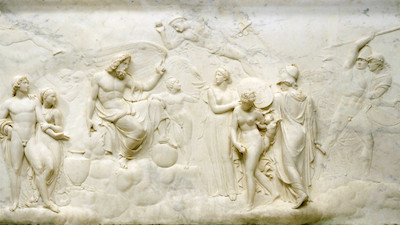 John Deare, Judgment of Jupiter, 1786–87, gift of Anna Bing Arnold
John Deare, Judgment of Jupiter, 1786–87, gift of Anna Bing Arnold
John Deare, an English sculptor who spent his entire professional career in Rome, was commissioned by the Royal Academy to create this relief for an exhibition in 1787. Deare's sculpture is a scene is from Homer's Iliad, depicting a fateful decision that would ultimately lead to the Trojan War.
Jupiter sits among the gods at the wedding of Peleus and Thetis (at left). All were invited except Eris, the goddess of discord. As payback for the slight, Eris tosses a golden apple inscribed "to the fairest" among the guests. Minerva, Juno, and Venus each claim it. Jupiter wisely refuses to pick the most beautiful goddess, and hands the apple to his messenger, Mercury, who flies above. Jupiter instructs Mercury to pass the apple—and the thankless task —to the mortal prince, Paris. Each goddess offers Paris a bribe—Juno would make him the king of Europe and Asia, while Minerva would grant him wisdom and skill in war. Paris chooses Venus, who presents him the most beautiful woman in the world as his wife. She is Helen of Sparta, who becomes Helen of Troy. The Greeks’ expedition to retrieve her is the mythological basis for the Trojan War, symbolized by Mars, the god of war, shown at the far right.
The Perfect Accord
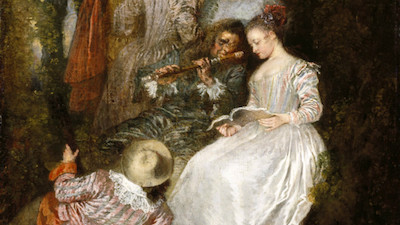 Jean-Antoine Watteau, The Perfect Accord (detail), 1719, gift of the Ahmanson Foundation
Jean-Antoine Watteau, The Perfect Accord (detail), 1719, gift of the Ahmanson Foundation
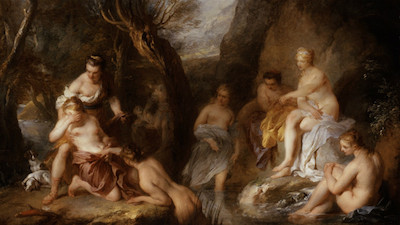 François Le Moyne, Diana and Callisto (detail), 1723, gift of the Ahmanson Foundation
François Le Moyne, Diana and Callisto (detail), 1723, gift of the Ahmanson Foundation
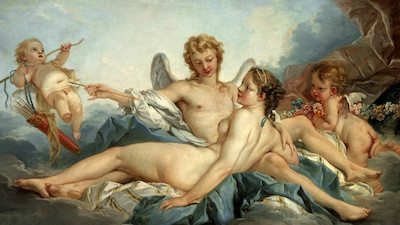 François Boucher, Cupid Wounding Psyche, 1741, gift of Hearst Magazines
François Boucher, Cupid Wounding Psyche, 1741, gift of Hearst Magazines
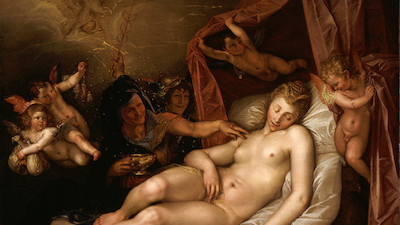 Hendrik Goltzius, The Sleeping Danae Being Prepared to Receive Jupiter (detail), 1603, gift of the Ahmanson Foundation
Hendrik Goltzius, The Sleeping Danae Being Prepared to Receive Jupiter (detail), 1603, gift of the Ahmanson Foundation
This love story has it all: lust, greed, and gold. Danae was the daughter of the king of Argos. Upon learning from the oracle at Delphi that he would be killed by his daughter’s son, the king imprisons Danae in a bronze tower to keep her childless. Jupiter is smitten by Danae’s great beauty, and disguises himself as a shower of gold coins that rains down upon the sleeping princess—the hero Perseus is born from this encounter. Perseus eventually kills his grandfather by accident, thus fulfilling the prophecy. The Sleeping Danae Being Prepared to Receive Jupiter (1603) was painted by Hendrik Goltzius, the leading Dutch engraver of the early Baroque period who later became a renowned painter. The Dutch valued hard work and wealth, but not greed. Goltzius’ painting celebrates the innocent beauty of the princess, but also provides a warning. Does love or gold conquer all?



